Apple Watch Series 4 review: The best smartwatch adds ECG, too
I am of two minds on the Apple Watch. On one hand, I think that it’s the best overall smartwatch you can currently buy. And to that end, the Series 4 is the best Apple Watch to date.
Mục Lục
The Good
The Apple Watch Series 4 offers a larger, crisp display that shows more with less bezel, super fast speed and a louder speaker. It adds high and low heart-rate detection, fall detection with SOS trigger and an FDA-cleared ECG app for more detailed heart readings.
The Bad
Starting prices are higher than last year. Battery life still won’t last past two days. Watch face options are still very limited in choice and function. It only works with iPhones.
The Bottom Line
The Apple Watch Series 4 is the fastest, most connected and best overall smartwatch around, but its battery life and watch face options often fall short of the competition.
After wearing one for months, it’s worked really well. And yes, it’s still my favorite smartwatch to use, because its smooth-running interface and tight iPhone-to-watch integration is better than what other smartwatches offer. But while this new model has a lot of refinement over previous versions, and a pretty great leap forward from older models such as the Apple Watch Series 1, it’s not as tremendous a leap forward from last year’s Apple Watch Series 3 as you might think.
Read more: All of the WatchOS 6 updates | Complete guide to Apple’s Health app | 18 devices that sync with Health App | 13 Apple Watch bands to get on Amazon
And the Apple Watch is no closer to being a clear must-have device than it was before, unless you value the possible benefits of new health features. For those looking for a fitness tracker, however, the S4 hasn’t changed much over the S3 at all.
The 2018 model adds a nice slate of upgrades:
- Thinner design with bigger, almost no-bezel watch faces: Larger 44mm and 40mm displays fit into the same general case sizes that previously held 42mm and 38mm ones, respectively.
- Lightning-fast speed: The Series 4 is fast. Response time for nearly everything that doesn’t require an online ping is effectively instantaneous. The improvement versus Series 2 and earlier models is particularly dramatic.
-
Fall detection
-
Electrocardiogram (EKG or ECG)
- GPS battery life on runs is improved a bit (6 hours instead of 4, which isn’t much, but it’s something).
On the other hand, there are still a number of downsides.
- The Series 4 is more expensive, starting at $399 (£399, AU$599). Larger sizes, optional cellular connectivity and upgrading to steel case or fancier straps runs the cost even higher.
- Battery life remains stuck at about a day and a half to two days on a charge, less if you’re using GPS, cellular or exercise frequently.
- No sleep tracking: Because the watch needs to be charged every day, that effectively dampens sleep tracking options. There are third-party apps, but nothing Apple offers as part of the core health experience.
- No always-on watch face: To save battery life, the watch face is dark most of the time.
- Despite a handful of new data-rich watch faces, the apps that use these faces are limited, and deeper customization — including having a
watch face store
To be clear, none of these missing pieces are futurist fantasies. Rival products from Fitbit, Samsung and others are starting to last for days — with promises of weeks between charges (in more pared-down watch modes) made by Qualcomm’s new chip that’s powering upcoming Google Wear OS watches. And those same products mostly offer sleep tracking, dozens or hundreds of watch face options, and always-on timekeeping, too.
Update, Dec. 21: Added testing of the now available ECG app. The score has not changed. Otherwise the rest of this review, first published on Oct. 19, is unchanged.
Get this model, stick with what you have, or look elsewhere?
New features like automatic workout tracking, walkie-talkie communications between watches, raise to talk (no more “hey Siri”) and better support for music and podcasts are all welcome additions to the Apple Watch. But those are part of the 2018 WatchOS 5 upgrade, so they’re also available on older Series 1, Series 2 and Series 3 models.
To that end, if you’re not a workout junkie, or someone who’s particularly interested in the safety aspects of fall detection or EKG-level heart monitoring, the Apple Watch Series 3 — available starting at $279 (£279, AU$399) — is still a worthy option. That model retains the standalone cellular option, too, if you want to occasionally go phone-free.
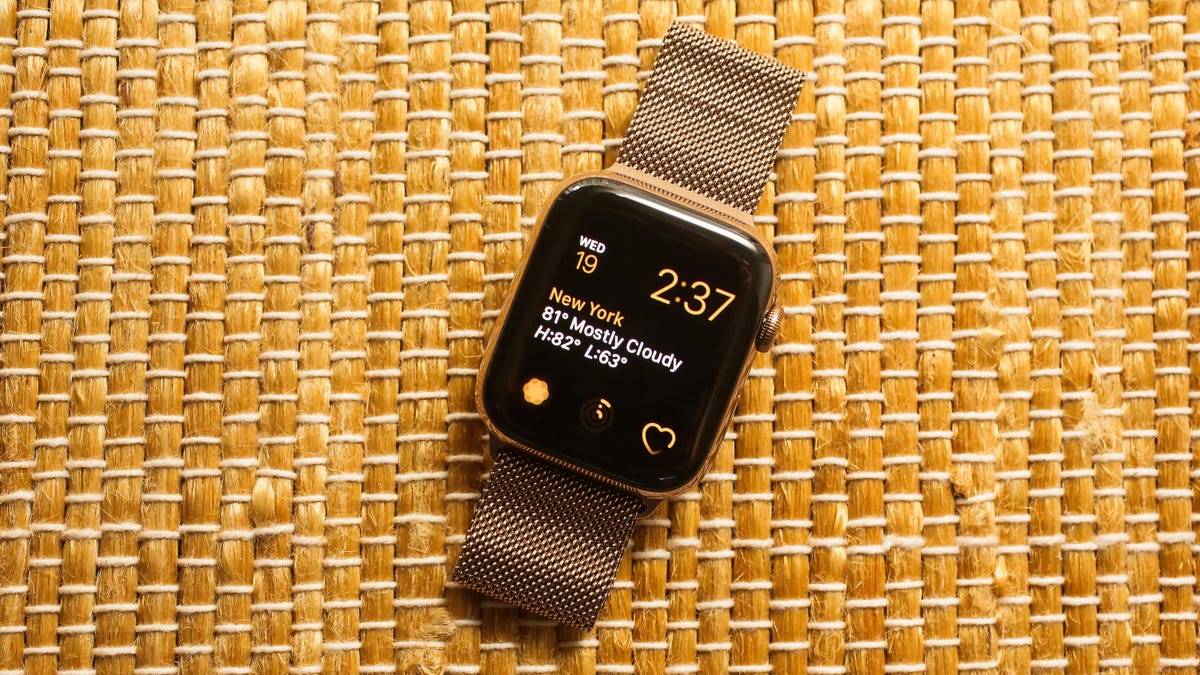
The Apple Watch Series 4 starts at $399 (£399, AU$599) for the standard model and $499 (£499, AU$749) for the LTE model. Models climb up from there depending on size, material (stainless steel versus aluminum), band choices and additional styles (Nike+, Hermes).
Existing Series 3 owners shouldn’t feel a rush to upgrade. And Series 1 and Series 2 owners should start with that free update to WatchOS 5, of course. But if you’re looking for considerably faster speed, a bigger and more information-rich watch face, and better health and workout features, the Apple Watch Series 4 is a worthy upgrade.
However, iPhone owners looking for a smartwatch with longer battery life or sleep tracking should check out alternatives like the Fitbit Versa.
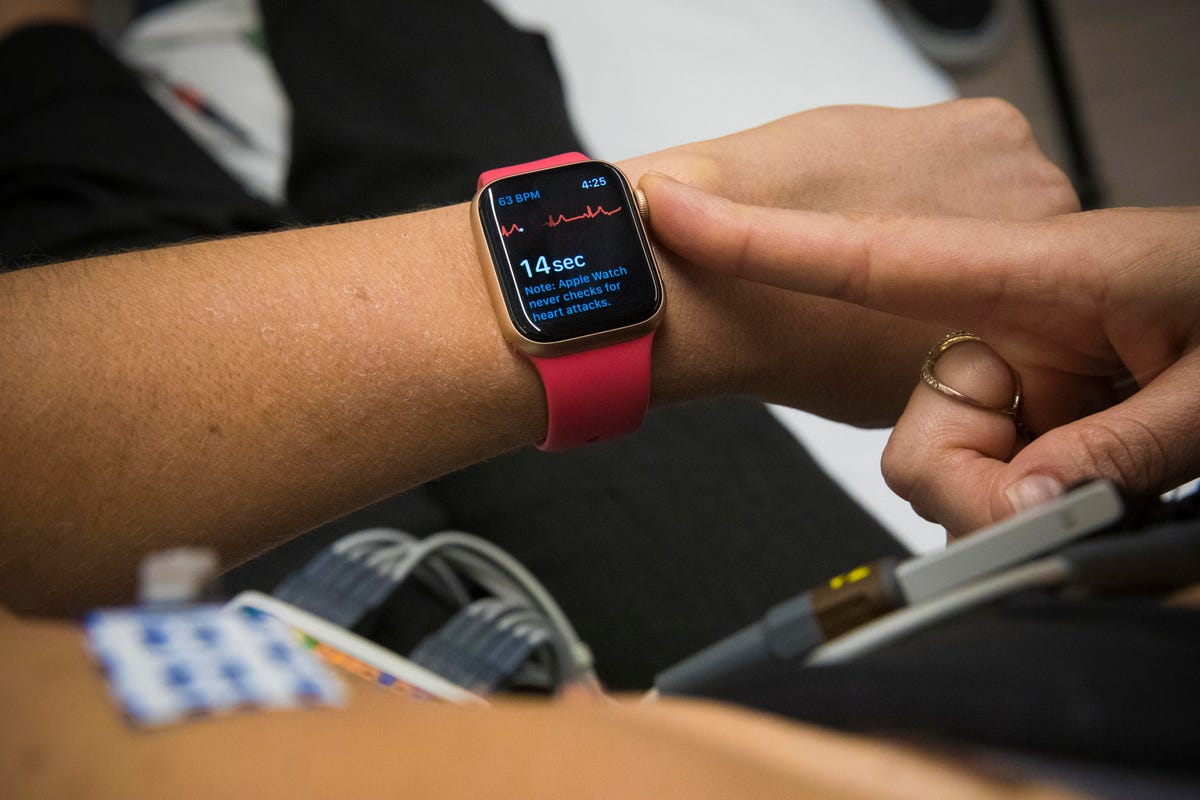
The new ECG feature takes 30-second heart rate samples while stationary.
Apple and ECG: Do you need it?
The most interesting new feature on the Series 4 watch, by far, is an FDA-cleared ECG app that can do more medically accurate on-the-spot heart rate checks. The Apple Watch is now an over-the-counter health device. But what that means for you may not be as sweeping as you’d think, even if it could help more people be aware of medical conditions they didn’t know they have.
ECG is short for electrocardiogram, which US doctors usually abbreviate to EKG. The one-lead ECG in the Apple Watch works much like a third-party band I tested last year made by Kardia. It takes a stationary 30-second heart-rate recording by completing an electrical circuit between the back of the watch and your finger on the digital crown. The heart reading can see the sort of peaks and valleys you’d see on a heart rate readout at a hospital, albeit less accurate than you’d get there (see below). But it can check for heart-rate rhythm abnormalities, which you’ll be notified of.
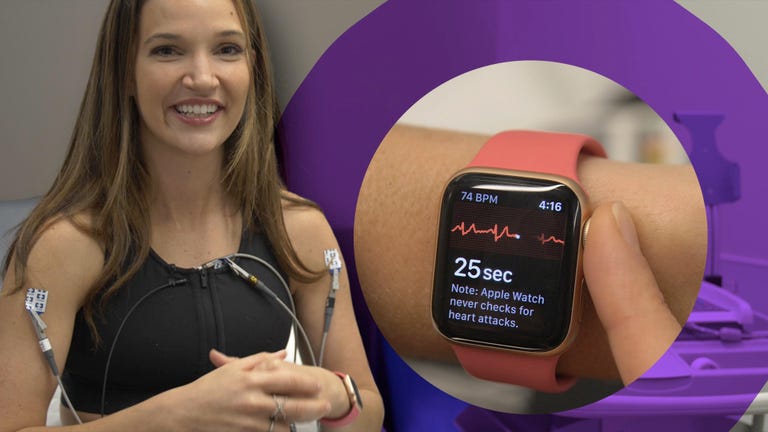
Watch this: We tested the Apple Watch EKG against a hospital EKG
04:28
But the ECG app has its limits. It’s a key step up, but it’s unlikely to be anyone’s comprehensive heart monitor — it isn’t even claiming that it can be.
CNET’s Vanessa Hand Orellana consulted with a doctor and compared Apple Watch’s ECG app to a hospital EKG. I’ve been using it for several weeks, and it’s been an extra feature I haven’t needed to dip into much. But I’ve taken a number of ECGs just because, and odds are you’ll do the same when you buy one.
- ECG isn’t always on. It is, by design, a 30-second spot check that does a deeper ping on your heart rate than what the normal optical green LED heart rate sensor can read. It’s made to check for one thing: abnormal heart rhythms. If the watch does notice an abnormal rhythm, it immediately suggests calling 911. If results are inconclusive, it suggests continuing to check and then calling your doctor.
- It needs to be activated via Apple’s Health app. From there, the app guides first-time users to how to it works, and what it can and can’t do. ECG readings are stored in the Health app, and can be sent to a doctor or shown during a doctor visit.
- The ECG onboard is a “one lead” ECG, which is only cleared to check for atrial fibrillation and arrhythmia only. It can’t detect heart attacks, and it’s not as comprehensive as a doctor’s 12-lead EKG, which can detect a lot more. It’s an early way to spot a possible problem.
- It’s meant to be used only at certain times. Apple says to use it when you’re not feeling well, or when the always-on heart rate detects a possible atrial fibrillation during its periodic checks.
That check for possible a-fib using the regular heart rate reader also works on Apple Watches going back to Apple Watch Series 1 when updated to WatchOS 5, but the deeper ECG analysis only comes with the Series 4.
ECG readers are also available separately, like Kardia’s little mobile-connected ECG device you could buy separately, or Kardia’s separately-sold watch band for older watch models that I tried last year. So you don’t need an Apple Watch S4 for ECG. But it’s a nice extra to have integrated into the Series 4 watch if you were already considering buying something like it, and it could be a key reason to upgrade for anyone concerned about heart health.
How key? That’s hard for anyone like me to say. My fellow editor Vanessa spotted a possible heart arrhythmia when using hers. I haven’t spotted anything yet as I’ve tried it. I have high blood pressure, and ECG does nothing to help me on that front. It will undoubtedly help people spot possible heart conditions, and it already has after just a few weeks of activation.
Other health features: Fall detection, low heart rate
The Apple Watch S4 can also detect falls, via its improved accelerometer, gyroscope and optical heart rate sensors.
Fall detection works via a combination of G-force impact and detection of arm and hand placement when falling, using the watch’s updated accelerometer and gyroscope. Apple’s testing and algorithms look for indicators that apparently only happen in “real” falls. After falling and detecting a fall, as long as the fall detection has been turned on in Apple Watch settings, the watch will call 911 via your phone or via its own cellular connection, and will then contact a designated friend or loved one to notify, along with your location.
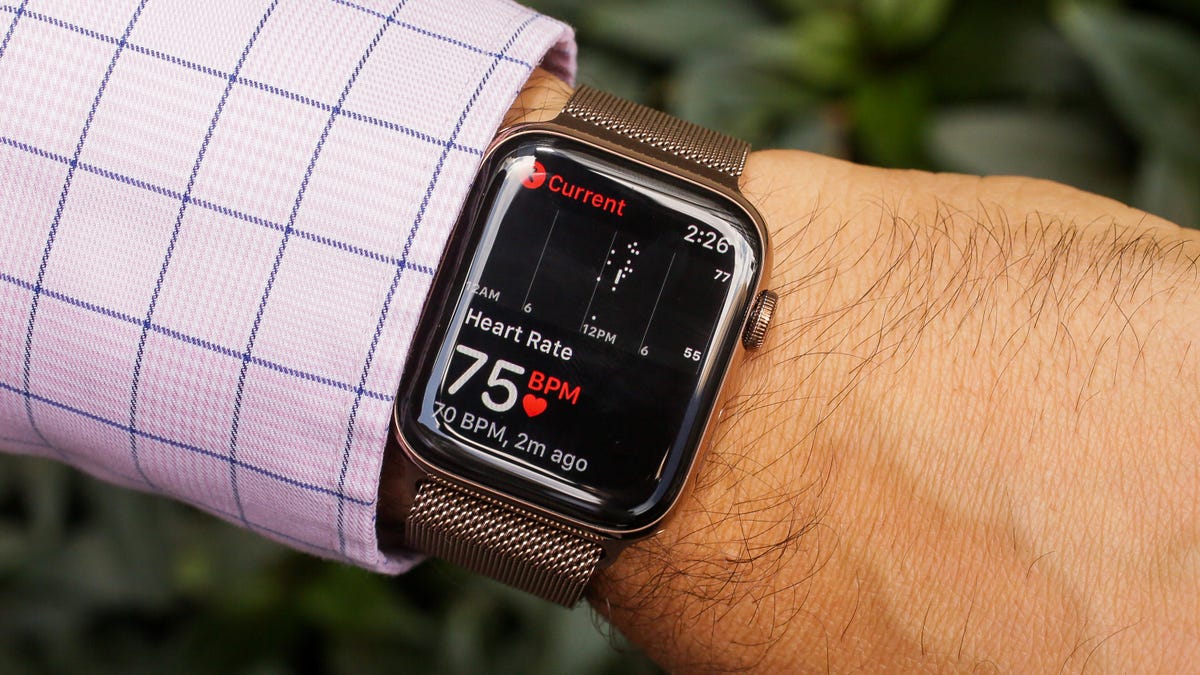
The heart-rate monitor now can send alerts for abnormally low or high sedentary heart rate, and can detect arrhythmia.
The new watch can also detect abnormally low sedentary heart rate, in much the same way that current Apple Watches can detect high sedentary heart rate. Either can possibly be a flag for medical problems, but not a guarantee that anything’s wrong.
While it’s great that Apple is pursuing new ways to explore health, these features come with caveats. Apple won’t guarantee successful fall detection, meaning that the app specifically warns that the watch’s fall-sensing may not work in every instance. I took a light, simple spill (as if I had collapsed, versus taken a sharp fall), and it didn’t detect. Unfortunately, the slight uncertainty factor means it can’t be a guaranteed monitor for a loved one that needs extra care.
And the heart rate monitoring may not necessarily spot all problems. Apple’s heart rate doesn’t scan constantly, like Fitbit’s trackers do, but it does check in every few minutes.
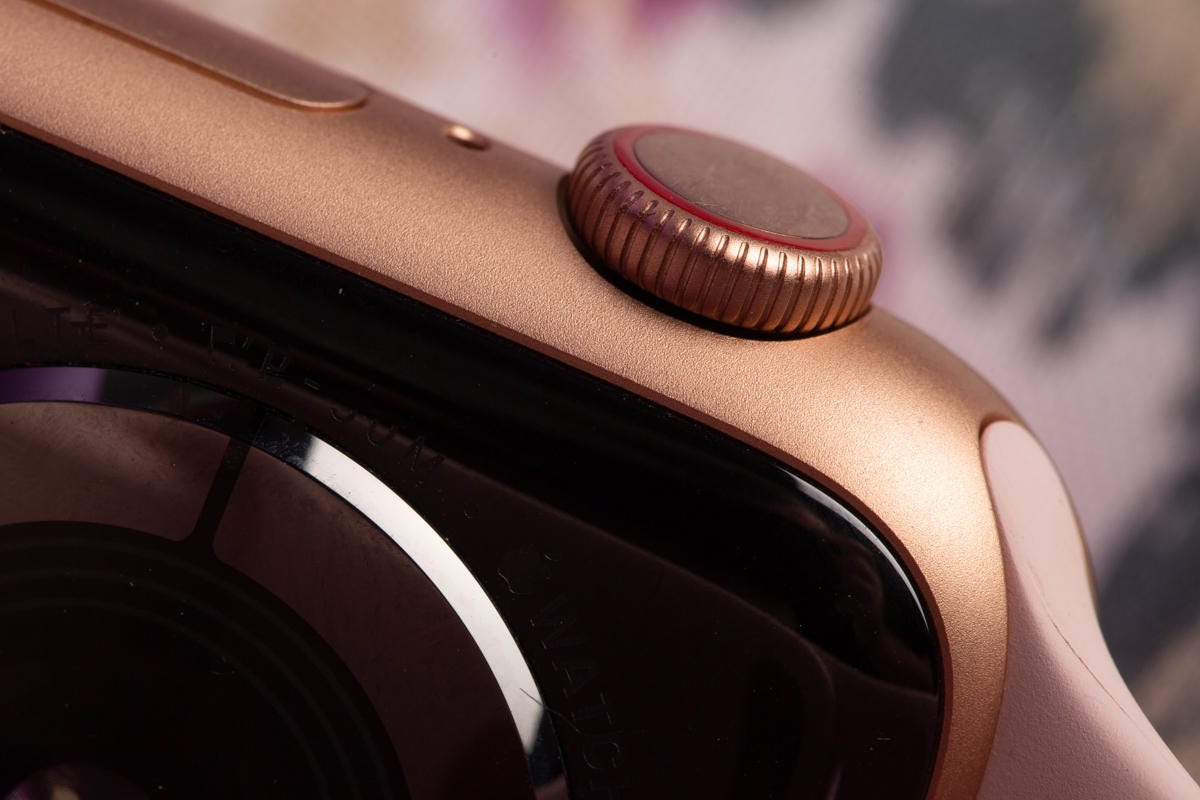
My favorite thing: Speed
The first Apple Watch in 2015 was slow. Loading apps was its limiting factor. The lightning-quick, smooth feel of the Apple Watch Series 4 almost feels like a given, since it’s how Apple products tend to feel out of the box. It’s as fast, now, as an iPhone or iPad. It feels automatic. Last year’s Series 3 was also fast, and it’s still fine. The Series 4 does it one better, so that loading times no longer seem to exist much at all.
Speed is probably more key on a watch than on a phone, if you’re counting on quick glances and instant info, I can’t think of a better wearable.
The Apple Watch interface design is mostly the same as last year, even with WatchOS 5. There are some key improvements: notifications now stack by type, much like on the iPhone in iOS 12, and it really helps with clutter. The Control Center (quick settings accessed via swipe-up) can also be reordered, front-loading most-needed controls (sadly, no new shortcuts can be added).
Speaking of shortcuts, Siri Shortcuts — which allow you to program activities with simple commands — are supported on the Apple Watch, but I haven’t found myself compelled to dive into using them yet.
My next favorite thing: Audio
More than the watch’s refined design, I truly appreciate the way it handles speakerphone functions. A louder speaker truly helps with quick Siri requests (which I really do, on my wrist, when setting timers or alarms or quick tasks). A new raise-to-speak function in WatchOS 5 means I can lift and talk really closely into the watch and not have to say “Hey Siri,” and it usually works. But for phone calls at home, when my phone’s lost somewhere and my sister or mom calls, I can talk with the whole family via my wrist and it works perfectly — it’s no different than a speakerphone call on the phone.
My good feelings on audio extend to the Apple Watch as iPod. Last year with WatchOS 4, the watch autosynced albums via Apple Music during overnight charging to fill an instant on-the-go library, and it made me use the watch for music far more than I expected. Podcasts and third-party audio apps can now work offline on the watch, too, and with a pair of AirPods (or other Bluetooth headphones, but AirPods pair and swap between iPhone and watch mostly seamlessly), it’s a perfect experience. I also appreciate the watch’s easy access to music controls when in a workout.
Bigger screen is better, but untapped watch face possibilities
The Apple Watch S4 is the biggest design update since the watch launched in 2015. Apple followed the model of its recent iPhone designs here: The Series 4 cuts down the bezel surrounding the screen versus last year’s Series 3, effectively squeezing larger screens into the same size chassis. It’s still a squircle, but the look is much more refined. It’s thinner, too: Apple cut the depth of the Watch from 11.4mm to 10.7mm, so it’s less bulbous on your wrist.
The Apple Watch still comes in “small” and “large,” but thanks to the economy of sizes from the redesign, the smallest new Apple Watch has a display that’s close to the size of the previous large one. The new watch sizes are 40 and 44mm, versus the previous 38 and 42mm.
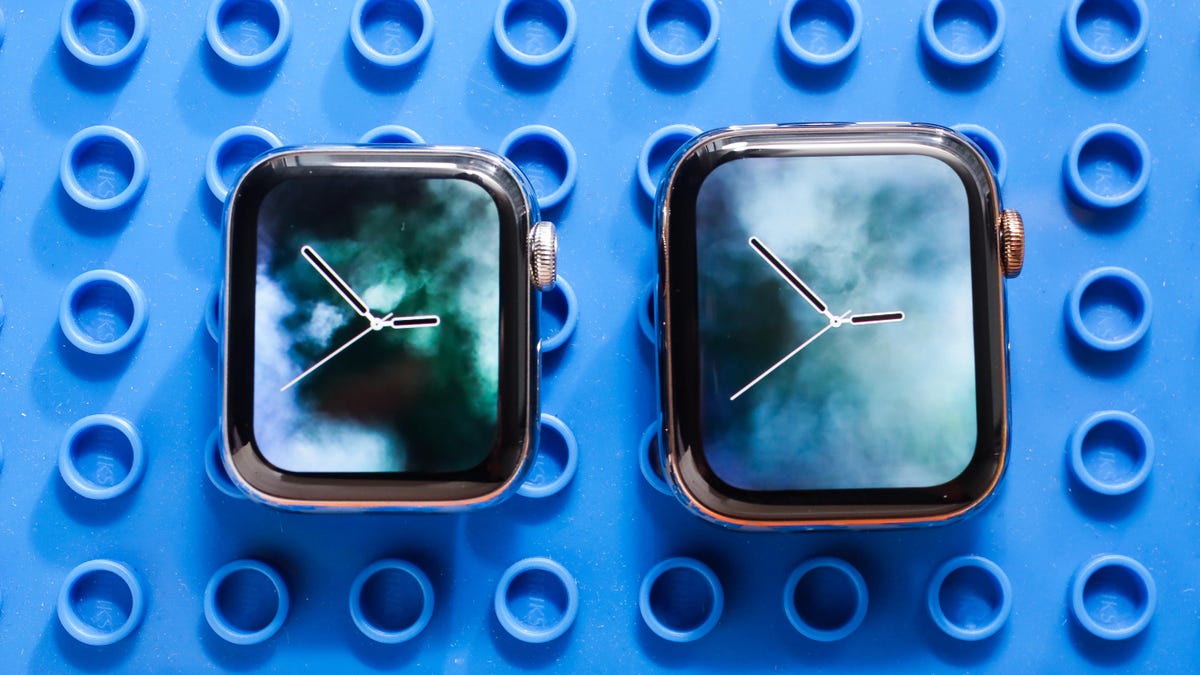
Both displays are bigger now, keeping case size still relatively compact. The 40mm (left) and 44mm (right), in stainless steel (gold colored steel is on the right).
The larger display on both sizes of Apple Watch models means bigger, more beautiful watch faces. But it doesn’t mean there’s all that much that’s new. There are only two signature new watch faces exclusive to the Series 4 — Infograph and Infograph Modular — and those faces show off new graphically rich complications for extra information on-watch. However, not all watch apps can take advantage of them yet, and even those that do aren’t as helpful as I expected. Heart rate, for instance, doesn’t show my heart rate or my resting heart rate on the watch face itself. Instead, it’s just a heart-shaped icon I can tap to launch the heart rate app.
Several weather apps can use the new “Infograph Modular” watch face’s center information pane to show daily weather trends, but few other apps can. And the areas where these complications are laid out can’t be moved around. For more thoughts, read my deeper dive into the new watch faces.
Other watch faces look bigger and prettier. New motion faces are full-screen, and the Kaleidoscope face looks brilliant and big. Round watch faces fill more of the available space. But they’re not fundamentally different, or any more customizable. I’d love to make my own styles of new watch faces, and build layouts that worked for me, using information I need. Apple has 25 watch faces to choose from and thousands of ways to tweak them and customize them, and yet I still find my ability to make my own perfect at-a-glance watch face is challenged.
I love the bezel-minimal, curved-corner display on the new watch, but with all the available space it now has, and the speed of the processor inside, Apple could be doing a lot more.
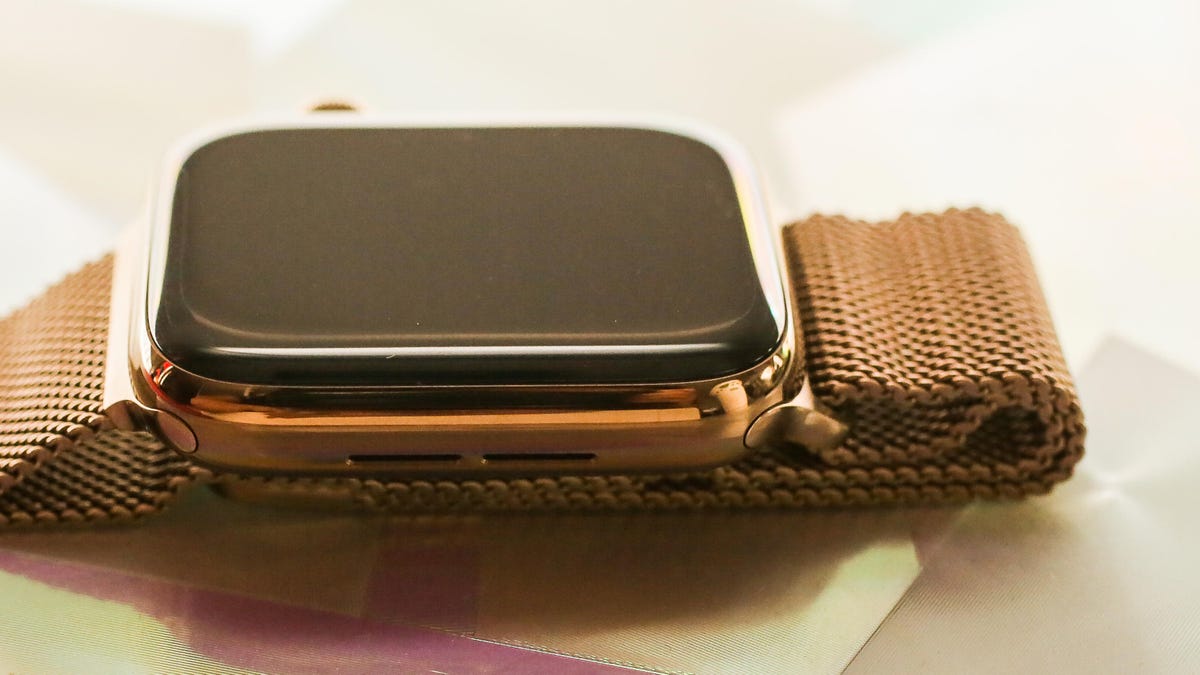
How gold is the gold? It’s more bronze-ish, and it’s growing on me — but I still wouldn’t get gold.
Other thoughts on the new design:
- The fuller display and its
iPhone X
- The digital crown on the side has subtle haptics now, so turning it produces realistic-feeling click mechanisms. It’s satisfying, but not necessary. The side button below lies more flush now. More importantly, the onboard speaker is louder and clearer, making Siri and phone calls a lot more useful (especially in emergencies).
- Good news on your old accessories: Bands fit the same as the older Apple Watches. I swapped my old ones in and traded bands to check. (Make sure you have the right size, though: 42 and 44mm sizes are interchangeable, and likewise 38 and 40mm.) The gold-colored steel Milanese band on my review model is a bit over the top for me.
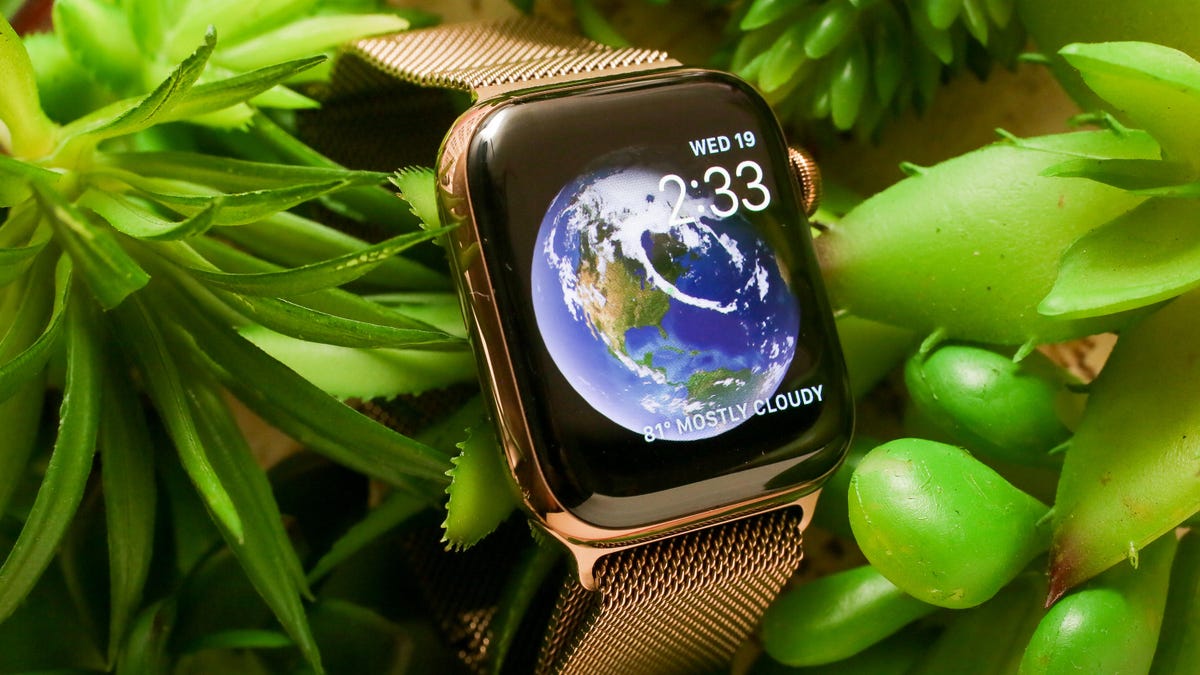
The Earth-view Astronomy watch face is a classic. Seen here on the 44mm gold steel version.
Battery: two days, max
If you wanted significantly better battery life in an Apple Watch, well, wait till next year. It still lasts roughly a day and a half to two days like it did before under normal usage — that is, without GPS and cellular data used much. Some might find that reasonable. But I see fitness trackers that last a week or more, and regular watches that can last indefinitely. Charging smartwatches is annoying.
That said, the Apple Watch Series 4 lasts longer when using GPS and measuring heart rate in workouts: around 6 and a half hours, based on my colleague Vanessa Hand Orellana’s tests. The Series 3 only lasted about 4 hours. An extra 2 hours may not mean much if you’re an all-day hiker, but if you’re running for hours it could make all the difference. But dedicated fitness watches like those from Garmin and Polar can last 20 hours or more with GPS engaged.
But if you’re not running and using GPS, battery life remains the same. And that means not really being able to wear the watch at night.
That also means Apple can’t fully explore a feature that’s on most other fitness trackers: sleep tracking. Despite buying Beddit in 2017, the Apple Watch doesn’t yet have baked-in sleep-tracking functions, which I find useful for tracking how good a night’s sleep I’m getting each night.
Cellular: Better connection, similar proposition
Connecting the Watch to a phone carrier for a fully connected away-from-iPhone experience is available for $100 more, plus $10 a month (or more) depending on your carrier. The new watch’s ceramic back does help cellular reception, and I found it easier to place calls and get service. Cellular still eats into battery life, so expect a day max, if you’re lucky. Also, while most key apps work via cellular (email, weather, music streaming via Apple Music and Podcasts, phone calls, Maps), not all do.
Fitness: The main advantage is a bit more battery life for GPS runs
Some years, the Apple Watch took big strides in fitness tech: adding GPS, swim tracking and water resistance, or even optional cellular. The revamped, improved accelerometer, gyroscope and heart-rate sensor on the Series 4 seem like they could help improve tracking, but none of that clearly plays out in everyday use. For runs, walks and gym workouts, this new Apple Watch does mostly the same thing as the Series 3.

Apple has improved many things over the years, and WatchOS 5 adds automatic workout detection, which is great. I still love the watch’s resting heart rate and walking heart rate averages (available last year as well via WatchOS 4), and heart-rate recovery calculations after a workout.
But there are no new fitness watch faces this year, no new insights served on-wrist, and — again — no onboard sleep tracking. Heart rate still can’t be served up as an always-on feature, like it can on a Fitbit. There aren’t any added PulseOx functions, like Garmin and Fitbit are pushing for in their wearables. And Apple’s limited social connectivity in its Activity app feels more isolated than using Fitbit’s social network.
Added battery life does mean 6 hours-plus on GPS runs, but that’s still far lower than what dedicated GPS watches offer. Vanessa gave the Series 4 a full workout — read her observations here and watch her video report below.
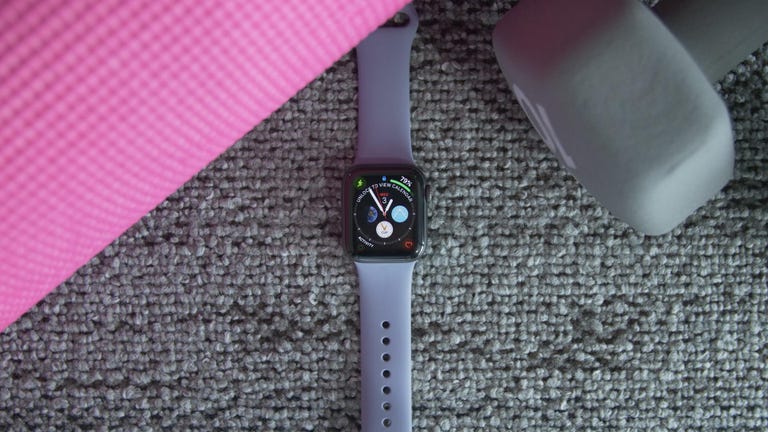
Watch this: The Apple Watch Series 4 delivers on its fitness promises
06:29
The leader of the smartwatch pack — but there’s more left to improve
The Apple Watch Series 4 earns bragging rights for its truly excellent connected features, zippy performance and best-in-class industrial design, and ever-improving health and fitness tracking. But I’m still waiting for the Apple Watch to step up its battery life like other fitness wearables are already offering. Maybe a low-power mode that can last a week, and also track sleep. I’d like an option for an always-on display. I’d like to have a way to get more watch faces, and to customize the ones that are there even more to the needs I have.
This first foot in the door to FDA-cleared medical tech is promising, and wild, and intriguing. But you’re not going to buy a new smartwatch every year. This year’s tech feels like a first step, and I’d wait at least a year to see where it all plays out — unless you really need better heart-rate alerts, feel an EKG is needed for you because of heart arrhythmia concerns (check with your doctor), would like something that watched for falls, or didn’t own a recent Apple Watch.
With a display this sharp and speed this fast, I’d just like to see Apple deliver even more. Or, push the boundaries of what a wearable assistant really means beyond having a fast, connected, beautiful, versatile mini phone on my wrist. But if you’re fine with the current prospects and have been waiting to get an Apple Watch, now may be a great time to come onboard.
Should you upgrade?
Series 1/2/3 users should upgrade to WatchOS 5 first: The latest version of WatchOS adds a bunch of extras to those 2016 and 2017 watches, including downloadable podcasts, a walkie-talkie mode and more watch faces. Try that out first — It could help pep up your older Apple Watch.
2015 Apple Watch owners have the most to gain: The original “Series Zero” Apple Watch can’t be updated to WatchOS 5. A Series 4 will be a compelling upgrade for anyone who wants a bigger screen and far more speed.
Series 3 owners will have the most difficult decision: You don’t need to upgrade, although you might want to if you need a faster experience or one of the key new features like the ECG app or fall detection. But the Series 3 is really the best value pick: at a reduced price, it’s still really good.






